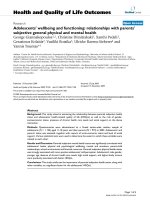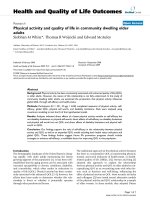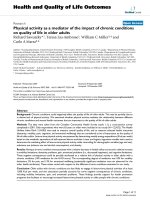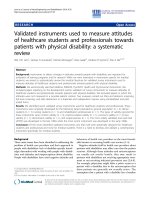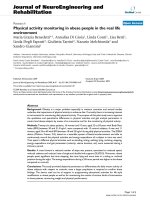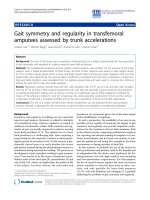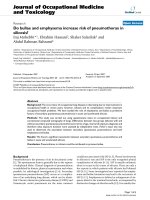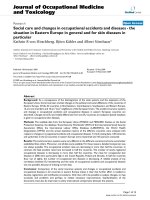báo cáo hóa học:" Physical activity and change in quality of life during menopause- an 8-year follow-up study" docx
Bạn đang xem bản rút gọn của tài liệu. Xem và tải ngay bản đầy đủ của tài liệu tại đây (158.86 KB, 20 trang )
This Provisional PDF corresponds to the article as it appeared upon acceptance. Fully formatted
PDF and full text (HTML) versions will be made available soon.
Physical activity and change in quality of life during menopause- an 8-year
follow-up study
Health and Quality of Life Outcomes 2012, 10:8 doi:10.1186/1477-7525-10-8
Jaana M Moilanen ()
Anna-Mari Aalto ()
Jani Raitanen ()
Elina Hemminki ()
Arja R Aro ()
Riitta Luoto ()
ISSN 1477-7525
Article type Research
Submission date 13 September 2011
Acceptance date 23 January 2012
Publication date 23 January 2012
Article URL />This peer-reviewed article was published immediately upon acceptance. It can be downloaded,
printed and distributed freely for any purposes (see copyright notice below).
Articles in HQLO are listed in PubMed and archived at PubMed Central.
For information about publishing your research in HQLO or any BioMed Central journal, go to
/>For information about other BioMed Central publications go to
/>Health and Quality of Life
Outcomes
© 2012 Moilanen et al. ; licensee BioMed Central Ltd.
This is an open access article distributed under the terms of the Creative Commons Attribution License ( />which permits unrestricted use, distribution, and reproduction in any medium, provided the original work is properly cited.
Physical activity and change in quality of life during menopause –an 8-year follow-
up study
Jaana M Moilanen
1
, Anna-Mari Aalto
2
, Jani Raitanen
1,3
, Elina Hemminki
2
, Arja R Aro
4
,
Riitta Luoto
3,5
.
1. School of Health Sciences, University of Tampere, Tampere, Finland.
2. Service system department, National Institute for Welfare and Health, Helsinki,
Finland.
3. UKK Institute for Health Promotion, Tampere, Finland.
4. University of Southern Denmark, Esbjerg, Denmark.
5. Department of children, young people and families, National Institute for Welfare and
Health, Helsinki, Finland.
E-mail addresses of the authors:
JMM:
AMA:
JR:
EH:
ARA:
RL:
Correspondence to:
Riitta Luoto
UKK Institute for Health Promotion
Post box 30
33501 Tampere
Finland
Abstract
Background and objectives. The aim of this study was to study the role of menopausal
status and physical activity on quality of life.
Methods. A total of 1,165 Finnish women aged 45-64 years from a national
representative population-based study were followed up for 8 years. Study participants
completed the Health 2000 study questionnaire and follow-up questionnaire in 2008.
Ordinal logistic regression analysis was used to measure the effect of menopausal status
on global quality of life (QoL). Other variables included in the analyses were age,
education, change of physical activity as assessed with metabolic equivalents, change of
weight and hormone therapy (HRT) use.
Results. Peri- and postmenopausal women increased their physical activity (28% and
27%) during the eight-year follow up period slightly more often than premenopausal
(18%) women (p=0.070). Menopausal status was not significantly correlated with change
of QoL. QoL of the most highly educated women was more likely to improve than
among the less educated (e
b
=1.28, 95%CI 1.08 to 1.51 p=0.002). Women whose
physical activity increased or remained stable had greater chances for improved QoL
than women whose physical activity decreased (e
b
=1.49, 95%CI 1.23 p<0.001 to 1.80,
e
b
=1.46, 95%CI 1.24 to 1.73 p<0.001 respectively). Women whose weight remained
stable during follow-up also improved their QoL compared to women who gained weight
(e
b
=1.26, 95%CI 1.07 to 1.50 p>0.01). Women who had never used HRT had 1.26
greater odds for improved QoL (95%CI 1.02 to 1.56 p=<0.05).
Conclusion. Improvement of global QoL is correlated with stable or increased physical
activity, stable weight and high education, but not with change in menopausal status.
Keywords: Menopause, physical activity, longitudinal study
Background
Women experience menopause between 40 and 58 years of age, the median age being 51
years [1]. Menopause is also a time of life with many symptoms and poor health status,
which affect quality of life [2,3]. Menopause is also associated with a number of
physical, psychological and social changes [4]. Many studies have found that the
menopause is associated with deteriorating quality of life (QoL) [5]. Menopause may be
accompanied by health problems with decreasing estrogen levels with symptoms such as
hot flushes, night sweats and vaginal dryness. In a number of studies menopausal
symptoms have been reported to be associated with quality of life indicators [6]. On the
other hand there are also study results indicating that well-being is not associated with
menopausal status per se but is associated with current health status [7].
Physical activity has been shown also to enhance quality of life among menopausal
women [8,9] and some studies suggest that physical activity is associated with a decrease
of hot flushes [10, 11]. The effect of physical activity in decreasing hot flushes has been
explained by ß-endorphin theory. It is known that increase of hypothalamic ß-endorphin
production may stabilize thermoregulation known to be disturbed during menopausal hot
flushes[12]. Physical activity may help in controlling body weight, which is associated
with more frequent vasomotor symptom reporting [10, 13]. It has been shown that weight
gain in midlife is not specifically related to menopause but to aging [14-16], and gaining
weight may impair quality of life [16, 17]. The question whether menopausal transition
could be considered as ‘window of opportunity’, i.e. whether there is any lifestyle
modification during menopausal transition, is left open.
Our aim was to study the role of physical activity and menopausal status in change in
quality of life among menopausal women.
Methods
The baseline data come from a health examination study entitled Health 2000. This was
carried out in Finland between 2000 and 2001 and has been described in detail elsewhere
[18, 19]. A nationally representative two-stage stratified cluster sample was drawn of
adults aged 30 and over and living in mainland Finland. A total of 7,419 subjects (93% of
the 7,977 subjects originally drawn from the population register) participated in one or
more phases of the study. Data collection included an extensive home interview, three
self-administered questionnaires and a clinical examination by a physician. The response
rate for the home interview was 87.6% and for the first self-administered questionnaire
84.4% among the whole study population. The response rate among women aged 45-64
years at baseline was 86.6%.
In 2008 all respondents who were 37-56 years old in 2000 (45-64 years old in 2008) were
sent a mailed questionnaire. After three reminders the overall response rate was 82.2%
(n=1,239). Of the respondents, 1 239 women who had responded both to the home
interview and to the self-administered questionnaire were included into this study
(n=1,165). In the 8-year follow-up study most of the questions and indicators were
similar to those in the baseline Health 2000 study (menopausal status, symptoms list,
quality of life, general health, coping at work).
Variables
Menopausal status and transition category
Women with a normal, regular menstrual cycle during the past 12 months were classified
as premenopausal, women with an irregular menstrual cycle during the past 12 months as
perimenopausal, and women whose last menstrual cycle had occurred more than 12
months ago as postmenopausal regardless whether HRT was used or not.
Three menopause transition categories were defined as: 1) premenopause at both baseline
and follow-up (pre-pre), 2) transition from premenopause to peri- or postmenopause (pre-
peri/post) and 3) perimenopause or postmenopause baseline and follow-up from
perimenopause to postmenopause (peri-peri/post, post-post).
Physical activity
Physical activity was measured by MET (Metabolic Equivalent) hours per week
(continuous variable) in years 2000 and 2008. MET variables were categorized as less
than 21 MET hours per week = low activity, 21-42 MET hours per week = moderate
activity and more than 42 MET hours per week = high activity.
Change in physical activity was defined as MET per week in year 2000 minus MET per
week in year 2008 and coded as decreased when the change was -1, -2 or -3, increased
when the change was 1 or 2 and when there was no change it was 0.
Physical activity variable MET per week was measured in the 2000 questionnaire with
the following questions: 1) How much time overall do you spend on heavy physical
activity on those days when you exercise for at least 10 minutes?”, 2) How much time
overall do you spend on moderate physical activity on those days when you exercise for
at least 10 minutes?”, 3. How much time overall do you spend on brisk walking on those
days you walk for at least 10 minutes?”. In 2008 questionnaire physical activity variable
MET per week was elicited with the questions: “How much time per week do you spend
on” a) brisk walking and rapid movement from one place to another or for recreation,
pleasure or fitness? b) do something that demands moderate physical effort, for example
cycling, vacuuming, gardening or some other function that cause some breathlessness and
increasing heart rate (do not count walking in this group)? c) do something that demands
hard physical effort, for example, running, aerobics, heavy gardening or some other
activity that causes heavy perspiration and rapid increase in heart rate. Response
alternatives were 1=not at all, 2=less than ½ hour per week, 3=one hour per week, 4=2-3
hours per week, 5=4 hours or more per week.
MET variable was developed for comparison of year 2000 and 2008 data concerning
physical activity. First we calculated MET from year 2000 data: how long time did
responders spend in physical activity (heavy, moderate and light) during each day (in
minutes). Minutes were then converted to hours and multiplied by 7 (one week time).
Thereafter physical activity was divided to five categories which were: 1=not at all,
2=less than ½ hour per week, 3=one hour per week, 4=2-3 hours per week, 5=4 hours or
more per week. Year 2008 data was already in this category format. MET variable was
then calculated by multiplying all categories with specified coefficient to make all
physical activity with different intensities comparable. Coefficients for different physical
activities are shown in table 1 (table 1). Thereafter we calculated MET hours and divided
them as 1) less than 21 MET hours per week=low activity, 2) 21-42 MET hours per week
= moderate activity and 3) more than 42 MET hours per week = high activity [20].
Weight
Weight was measured in kilograms in both 2000 and 2008 surveys. Body mass index was
defined as weight (kg)/height squared (m
2
). Change in (kg) weight was defined as weight
in 2000 minus weight in 2008. Stable weight was defined as weight in 2008 between -5.0
and 5.0 kg of weight in 2000. Women who lost or gained more than 5.0 kg were
classified respectively as weight losers and weight gainers.
Quality of Life
Quality of life (QoL) was measured on the Ladder of Life scale modified by Andrew and
Withey[21]. Respondents were asked to evaluate their QoL during the previous month.
The scale was from 0 to 10 with 0 meaning worst possible quality of life and 10 meaning
best possible quality of life. Responses were categorized as 0-4 (poor), 5-7 (moderate), 8
(good), 9-10 (excellent) [22]. Change in quality of life was defined as QoL in 2000 minus
QoL of life in 2008 resulting in the categories -3, -2, -1 defined as deteriorated QoL, 0
defined as no change and 1 or 2 defined as improved QoL.
Hormone therapy (HRT)
Hormone therapy (HRT) use was defined at baseline by last month of using HRT and at
8-year follow-up during year 2008 use during last six months. Categories in both baseline
and follow-up surveys were similar- current, previous and never users. Current users
were women who used HRT when they answering the questionnaire. Previous users had
used HRT before but not now. Never users were those who did not report any use of HRT
at baseline or follow-up, or the period between these survey timings.
Statistical analysis
Baseline and follow-up characteristics were tabulated (mean and standard deviations) or
as proportions and percentages. Differences between baseline and follow-up values were
evaluated using McNemar’s test. Changes in physical activity in different menopausal
groups were tabulated with proportions and percentages. Differences between
menopausal groups were tested using chi square test.
The effect of menopausal status and change in physical activity on quality of life changes
was tested with ordinal regression analyses. The models included baseline QoL, age,
education (primary, secondary and tertiary), weight change and use of hormone
replacement therapy (HRT). We used ordinal logistic regression since the dependent
variable (quality of life) was not normally distributed and was ordinal scale (-2 and -
1=declined, 0=stable, 1 and 2=improved) and thus did not meet the criteria for linear
regression analyses. Quality of life change was used as dependent variable, menopausal
status and change in physical activity (MET hours/week) as confounding factors (QoL at
baseline, age, education, weight change as independent variables).
We used ordinal regression although testing parallel lines assumption showed that the
general model did not greatly improve the fit. We also conducted a multinomial
regression analysis because of this absence of assumptions and obtained the same results
as in the ordinal regression. Ordinal regression is easier to interpret than multinomial
regression analysis. Results of the ordinal model are interpreted in such a way that larger
coefficients (> 1) indicate an association with larger scores, lower coefficients (<1)
association with lower scores, respectively.
The full model was adjusted for age, education, menopause status, change in physical
activity and change in weight. All analyses were performed using the Statistical Package
for the Social Sciences, version 15.0 statistical packages.
Results
At baseline the mean age of the study sample was 47.0 years and in 2008 it was 56.0
years. The proportion of women reporting at least moderate physical activity (at least 21-
42 MET hours) was higher at the follow-up as compared to baseline (p>0.001). The
proportion of women with overweight (33% to 34%) or obesity (24% to 23%) was stable
over time. At baseline over half of the women (67%) were premenopausal and in 2008
only a fifth of women (19.9%). Among all women 38% reported excellent quality of life
at baseline, but only 26% at 2008 follow-up. Proportion of women using HRT was higher
at 2008 as compared to year 2000 (Table 2)
Women whose menopausal status changed from premenopause to perimenopause or
postmenopause increased their physical activity (28% and 27%) during the 8-year follow-
up more often than did premenopausal women (18%) and the differences were close to be
significant (p=0.070) (Table 3). There were no significant differences between the three
groups in changes in QoL (p=0.38) or weight change (p=0.38). However, proportion of
women whose quality of life deteriorated was higher among women in menopausal
transition (41.5%) than compared to premenopausal women (34.5%) or postmenopausal
women (34.9%). Proportion of weight gainers was highest among premenopausal women
as compared to other groups (Table 3).
QoL of the most highly educated women had improved more than QoL of the least
educated women (Table 4). Women whose physical activity increased or remained stable
had improved QoL more often than women whose physical activity diminished. Women
whose weight remained stable were more likely to have better QoL than women who
gained weight during follow-up. Women who had never used HRT had better QoL than
women who were current HRT. Women who were current HRT users had more
deterioration in quality of life than women who had never used HRT (results not shown
in the tables).
Discussion
The aim of this study was to assess the relationships between changes in quality of life,
menopausal status and physical activity. Change in global quality of life is more
associated with change in physical activity than change in menopausal status. Similar
findings have been reported in other studies [23]. However, women whose physical
activity or weight remained the same, physical activity increased or women who were the
most highly educated, had improved QoL over time. Mishra et al. [24] in their
longitudinal study with 2 years of follow-up found that certain domains of QoL decline
with aging and physical aspects of general health and well-being measured by SF-36
scale declined during the menopausal transition. Women who were perimenopausal for at
least a year reported greater decline in their physical health and psychosomatic domains
than did premenopausal women [24].
Peri- and postmenopausal women increased their physical activity during the 8-year
follow-up compared to premenopausal women Physical activity has been reported to
decrease with age [25], but in our study it seems that women in menopausal transition
changed their behaviour in another direction. Increased motivation for lifestyle
modification during menopausal transition could explain this increasing physical activity.
Elavsky et al. [ 26] in their longitudinal study found that physical activity improves
physical self-worth and positive affect and that the improvements in affect lead to
improvements in QoL. In our study those women who decreased their physical activity
had deterioration in QoL than did women whose physical activity remained stable.
Women who increased their physical activity improved their QoL. In the study by
Elavsky et al. [26] increase in physical activity mediated positive affect and therefore had
an effect on QoL. Some other studies claim that physical activity alleviates menopausal
symptoms (hot flushes) and so improves QoL [11, 27]. It is hypothesized that endorphin
concentration in the hypothalamus decreases and oestrogen production declines,
facilitating the release of norepinephrine and serotonin. Exercise may have similar
ameliorating effects on vasomotor symptoms by increasing the presence of hypothalamic
and peripheral ß-endorphin production. Through these mechanisms, exercise may help to
stabilize the thermoregulatory centre and diminish the risk of hot flushes [28]. The
relationship between physical activity and QoL during the menopause is complex and
may involve a number of alternative mechanisms, physiological or psychological or both.
Women who gained weight were more likely to report deterioration in QoL. This is
consistent with other studies [23, 16]. The eight-year follow-up study by Dennerstein et
al.[23] found that increase of body mass index was associated with decline in self-rated
health. Whether this is because of their knowledge of the relationship between body
fatness and chronic disease or whether it reflects a problem with body image is unknown.
In the study by Sammel et al. [16] the major predictors of weight gain among menopausal
women were quality of life and other psychological factors including depressed mood
and anxiety. One might speculate some causality between these factors; did weight gain
lead to decline in QoL or did poorer QoL lead to weight gain? The Study of Women´s
Health Across the Nation (SWAN) [29], which is a multiethnic cohort study, found that
women who had gained weight during the study period reported more vasomotor
symptoms (hot flushes) than women whose weight remained stable and hence also poorer
QoL.
However, the question of association between obesity and vasomotor symptoms is
contradictory. Obese postmenopausal women have an increased peripheral conversion of
androstenedione to estrone in adipose tissue compared to normal weight women, might
be associated with fewer hot flushes in overweight women. On the other hand, lean
women have more hot flushes at the time of menopause [30] and they have been shown
to use HRT more frequently [31], although opposite results also exist [32]. Stadberg et al
[33] found that a higher BMI was correlated with a higher climacteric symptom score.
They thought that possible reason maybe that overweight women sweat more often
because of their extra weight load and obesity is also associated with less exercise and
poorer general health. Overweight could also be viewed as a lifestyle factor with less
concern about health and lower self-esteem [34].
It was a limitation of our study that information on QoL was elicited only in one straight
question, not different dimensions of quality of life, as for example the SF-36 Health
Survey questionnaire. In SF-36 scale there are 36 items assessing eight dimensions of
quality of life. The global QoL scale is self-anchoring because ratings are made relative
to each person´s conception of her best or worst QoL. Nor could we use symptoms
questions in a longitudinal perspective because the questions in the baseline and follow-
up studies were different and thus not comparable.
The main strengths of our study were the size and the fact that it was longitudinal study
on Finnish female population with a high response rate. The longitudinal nature of the
study meant that it was possible to thoroughly investigate change in physical activity and
other related factors during the menopausal transition between two time points.
Conclusion
Menopausal transition was not significantly correlated with change in global QoL during
8-year follow-up. However, women who increased their physical activity, had stable
weight or were most highly educated had improved QoL. Our study pinpoints the
importance of physical activity increase during menopausal transition and also supports
the hypothesis that menopause may be a window of opportunity, since it may induce
lifestyle modification.
Competing interests
We declare that there are no competing interests related to the article.
Acknowledgements
Academy of Finland and Ministry of Education have supported financially the
project.
Authors´ contributions
RL and JMM originated the idea for study. RL, JMM, AMA, ARA and EH planned the
study questions and analysis. JR and JMM were responsible for statistical analysis. JMM
prepared the first version of the manuscript. All authors (RL, AMA, EH, ARA, JMM and
JR) participated in drafting of manuscript and approved the final version.
References
[1] Zapantis G, Santoro N. The menopausal transition: characteristics and
management. Best Practice and Research Clinical Endocrinology
Metabolism. 2003;17:33-52.
[2] Utian W. Psychosocial and socioeconomic burden of vasomotor symptoms in
menopause: A comprehensive review. Health Qual Life Outcomes. 2005;5;3:47.
[3] McVeigh C. Perimenopause: more than hot flushes and night sweats for some
Australian women. J Obstet Gynecol Neonatal Nurs. 2005;34:21–27.
[4] Kumari M, Stafford M, Marmot M. The menopausal transition was associated
in a prospective study with decreased health functioning in women who
report menopausal symptoms. Journal of Clinical Epidemiology 2005;58:719-
727.
[5] Blumel J.E, Castelo-Branco C, Binfa L Gramegna G, Tacla X, Aracena B,
Cumsille MA, Sanjuan A. Quality of life after the menopause : a population
study. Maturitas 2000;34:17-23.
[6] Schneider HPG. The quality of life in the post-menopausal woman. Best Pract
Res Clin Obstet Gynaecol 2002;16:395-409.
[7] Dennerstein L. Well-being, symptoms and the menopausal transition.
Maturitas 1996;23:147-157.
[8] Elavsky S. Physical activity, menopause and quality of life: The role of affect
and self-worth across time. Menopause 2009;16:265-271.
[9] Courneya KS, Tamburrini AL, Woolcott CG, McNeely ML, Karvinen K,
Campbell KL, McTierman A, Friedenreich CM. The Alberta physical activity
and breast cancer prevention trial: quality of life outcomes. Prev Med
2011;52:26-32.
[10] Gold EB, Sternfeld B, Kelsey JL, Brown C, Mouton C, Reame N, Salamone L,
Stellato R. Relation of demographic and lifestyle factors to symptoms in a?
multi-racial/ethnic population of women 40-55 years of age. Am J Epidemiol
2000;152:463-73.
[11] Ivarsson T, Spetz A-C, Hammar M. Physical exercise and vasomotor symptoms
in postmenopausal women. Maturitas 1998;29:139-146.
[12] Hammar M, Berg G, Lindgren R. Does physical exercise influence the
frequency of postmenopausal hot flushes? Acta Obst Gyn Scand. 1990;69:409-
12.
[13] Thurston RC, Sowers MF, Sternfeld B, Gold EB, Bromberger J, Chang Y, Joffe
H, Crandall CJ, Waetjen LE, Matthews KA. Gains in body fat and vasomotor
symptom reporting over menopausal transition. The American Journal of
Medicine 2009;170:766-774.
[14] Wing RR, Matthews KA, Kuller LH, Meilahn E N, Plantiga PL. Weight gain at
the time of menopause. Arch Intern Med 1991;151:97-102.
[15] Wang Q, Hassanger C, Ravn P, Wang S, Christiansen C. Total and regional
body composition changes in early menopausal women; age related or
menopause? Am J Clin Nutr 1994;60:843-848.
[16] Sammel M.D, Grisso J.A, Freeman E.W, Hollander L, Liu L, Liu S, Nelson D.B,
Battistini M. Weight gain among women in the late reproductive years.
Family practice 2003;20:401-411.
[17] Matthews KA, Bromberger JT. Does the menopausal transition affect health-
related quality of life? The American Journal of Medicine 2005;118:25S-36S.
[18] Aromaa A & Koskinen S (eds). Health and functional capacity in Finland.
Baseline results of the Health 2000 Health examination survey. Publications of
the National Public Health Institute B12/2004, Helsinki.
[19] Heistaro S (ed.) Methodology Report. Health 2000 Survey. Publications of the
National Public Health Institute B26/2008, Helsinki.
[20] Ainsworth BE, Haskell WL, Whitt MC, Irwin ML, Swartz AM, Strath SJ,
O'Brien WL, Bassett DR Jr, Schmitz KH, Emplaincourt PO, Jacobs DR Jr,
Leon AS. Compendium of physical activities: an update of activity codes and
MET intensities. Med Sci Sports Exerc 2000;32:498-504.
[21] Andrews FM, Withey SB. Social indicators of well-being:
Americans´perceptions of life quality. New York: Plenum, 1976.
[22] Avis NE, Assmann SF, Kravitz HM, Ganz PA, Ory M. Quality of life in
diverse groups of midlife women: Assessing the influence of menopause,
health status and psychosocial and demographic factors. Quality of Life
Research 2004;13:933-946.
[23] Dennerstein L, Dudley EC, Guthrie JR. Predictors of declining self-rated health
during the transition to menopause. Journal of Psychosomatic Research
2003;54:147-153.
[24] Mishra GD, Brown WJ, Dobson AJ. Physical and mental health: Changes
during menopause transition. Quality of life Research 2003;12:405-412.
Utian 2005
[25] Pedersen P, Kjøller M, Ekholm O, Grønbæk M, Curtis T. Readiness to change
level of physical activity in leisure time among physically inactive Danish
adults. Scand J Public Health 2009;37:785-792.
[26] Elavsky S. Physical activity, menopause, and quality of life: The role of affect
and self-worth across time. Menopause 2009;16:265-271.
[27] Dennerstein L, Lehert P, Guthrie JR, Burger HG. Modeling women´s health
during the menopausal transition: a longitudinal analysis. Menopause
2007;14:53-62.
[28] Reid RL, Hoff JD, Yen SS, Lee CH. Effects of exogenous beta h-endorphin on
pituitary hormone secretion and its disappearance rate in normal human
subjects. J Clin Endocrinol Metab 1981;52:1179-83.
[29] Thurston R.C, Sowers MF, Chang Y, Sternfeld B, Gold EB, Johnston JM,
Matthews KA. Adiposity and reporting of vasomotor symptoms among
midlife women. The study of women´s health across the nation. Am J of
Epidemiol 2008;167:78-85
[30] Erlik Y, Meldrum DR, Judd HL. Estrogen levels in postmenopausal women
with hot flushes. Obstet Gynecol 1982;59:403-7.
[31] Jalava-Broman J, Mäkinen J, Ojanlatva A, Jokinen K Sillanmäki L, Rautava P.
Tratment of climacteric symptoms in Finland prior to the controversial
reports on hormone therapy. Acta Obstetrica et Gynecologica 2008;87:682-6.
[32] Den Tonkelaar I, Seidell J, van Noord P. Obesity and fat distribution in
relation to hot flushes in Dutch women from the DOM-project. Maturitas
1996;23:301-5
[33] Stadberg E, Mattson L-Å, Milsom I. Factors associated with climacteric
symptoms and the use of hormone replacement therapy. Acta Obstet Gynecol
Scand 2000;79:286-92.
[34] Kirchengast S. Realtions between antropomethric characteristic and degree of
severity of climacteric syndrome in Australian women. Maturitas
1993;17:167-80.
Table 1. Coefficients for physical exercise
Time spent Light physical
exercise
Moderate physical
exercise
Heavy physical
exercise
1=not at all 0 0 0
2=less than ½ hour
per week
+1.5 +2.5 +3.25
3=one hour per
week
+4.5 +7.5 +9.75
4=2-3 hours per
week
+15.0 +25 +32.5
5=4 hours or more
per week
+30.0 +50.0 +65.0
Table 2. Baseline characteristics of the cohort study: age, socioeconomic background and
lifestyle (N=1165)
2000 2008 McNemar-
test
N % N %
Age (SD)
47.0 (5.2) 56.0 (5.2)
Education
Primary 309 26.5 - -
Secondary 381 32.7 - -
Tertiary 475 40.8 - -
Quality of life
1)
<0.001
0-4 (poor) 19 1.6 62 5.4
5-7 (moderate) 291 25.0 337 29.2
8 (good) 406 34.9 460 39.8
9-10 (excellent) 446 38.4 297 25.7
MET hours/week
2)
<21 238 20.7 157 13.6 >0.001
21-42 249 21.6 322 27.9
>42 665 57.7 677 58.6
BMI (kg/m2)
3)
0.068
<25 521 45.2 478 42.3
25-29.9 369 32.0 388 34.4
>30 263 22.8 263 23.3
Menopausal status
4)
>0.001
Premenopausal 772 67.0 232 19.9
Perimenopausal 82 7.1 170 14.6
Postmenopausal 298 25.9 762 65.5
Hormone replacement
therapy use
5)6)
>0.001
current 267 23.0 425 36.9
previous 128 11.0 183 15.9
never 767 66.0 545 47.3
1) missing 12
2) MET= metabolic equivalent hours, missing 47
3) missing 20
4) missing 14
5) missing 12
6) 2000: last month 2008:last six month
Table 3. Change of global QoL, physical activity and weight during 8-year follow-up
by menopausal group
Changes Pre-pre
a
) Pre-peri/post
b)
Peri-peri/post,
post-post
c)
p-value*
(n=229)
(n=535)
(n=762)
N % N % N %
Quality of life
1)
-2 19 8.3 40 7.5 27 7.2 0.376
-1 60 26.2 182 34.0 104 27.7
0 103 45,0 221 41.3 177 47.2
1 40 17.5 72 13.5 55 14.7
2 7 3.1 20 3.7 12 3.2
Physical
activity
2)
0.070
Decrease 52 22.6 109 20.6 79 21.2
Stable 137 59.6 274 51.9 194 52.0
Increase 41 17.8 145 27.5 100 26.8
Weight/kg
3)
0.379
Losers <5kg 21 9.2 64 12.0 49 13.1
Stable ± 5kg 157 68.6 377 70.6 257 68.9
Gainers >5kg 51 22.3 93 17.4 67 18.0
1)
missing 26
2)
missing 34
3)
missing 29
* tested with chi square test
a)
premenopause at both baseline and follow up
b)
transition from premenopause to peri- or postmenopause
c)
perimenopause or postmenopause both at baseline and follow-up; from perimenopause
at baseline to postmenopause at follow-up
Table 4. Ordinal regression analysis for change in quality of life (dependent variable),
results from a model including all covariates shown in the table.
N e
ß
CI (95%)
Age (years)
1097 1.01 0.99 to 1.30
Menopausal transition
status
Pre-pre
a)
225 1 (ref.)
Pre-peri,post
b)
513 0.93 0.77 o 1.14
Peri-peri/post.post-post
c)
359 0.88 0.70 to 1.11
Education
primary 284 1 (ref.)
secondary 358 1.01 0.85 to 1.21
tertiary 455
1.28** 1.08 to 1.51
QoL at baseline
poor 19 14.18 8.38 to 24.00
moderate 271 5.94 4.91 to 7.19
good 383 1.95 1.67 to 2.28
excellent 424 1 (ref.)
Physical activity
change (MET/week)
decrease 232
1
stable 590
1.46*** 1.24 to 1.73
increase 275
1.49*** 1.23 to 1.80
Weight change
gainers 208 1
stable 765
1.26** 1.07 to 1.50
losers 124 1.20 0.94 to 1.53
HRT Use in baseline
Current 403
1
Before 177
0.73
0.73 to 1.18
Never 517
1.26* 1.02 to 1.56
R
2
(Nagelkerke) 0.340
Interpretation of results: if eß >1, the odds of higher QoL are greater, whereas when eß<1 low QoL is more
probable.
*p<0.05
**p<0.01
***p<0.001
a)
premenopause at both baseline and follow up
b)
transition from premenopause to peri- or postmenopause
c)
perimenopause or postmenopause both at baseline and follow-up; from perimenopause at baseline to
postmenopause at follow-up

